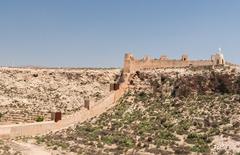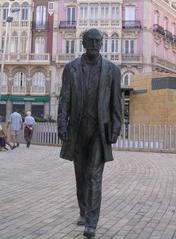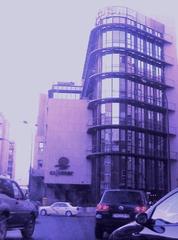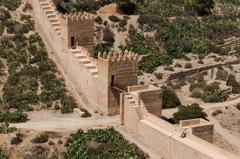
Visiting the Port of Almería, Spain: Complete Guide with Hours, Tickets, and Tips
Date: 03/07/2025
Introduction
Nestled on the southeastern Mediterranean coast of Spain, the Port of Almería stands as a dynamic maritime gateway blending a rich tapestry of history with modern commercial and passenger operations. Once a prehistoric trading post and later a flourishing Islamic naval base, today the port is a bustling center for ferry connections to North Africa and a hub for visitors seeking Andalusia’s cultural and architectural treasures. In this comprehensive guide, you’ll find essential information on visiting hours, ticketing, accessibility, and nearby attractions, along with practical travel advice to make the most of your visit to this iconic Andalusian port (Visit-Andalucia, Wikipedia, Spain.info, Ferryhopper, Official Port of Almería website).
Contents
- Historical Overview
- Prehistoric and Ancient Maritime Roots
- Islamic Foundation and Golden Age
- Medieval Shifts and Christian Conquest
- 19th-Century Industrialization and Expansion
- 20th Century: War, Decline, and Recovery
- Contemporary Port: Modernization and International Connections
- Visiting the Port of Almería
- Visiting Hours
- Tickets and Tours
- Special Events and Activities
- Accessibility
- Nearby Attractions
- Frequently Asked Questions (FAQ)
- Practical Visitor Information
- Conclusion and Recommendations
- Sources
Historical Overview
Prehistoric and Ancient Maritime Roots
The Port of Almería’s origins are deeply rooted in prehistory. Archaeological evidence from Los Millares, a Copper Age settlement (c. 3200–2200 BCE), reveals early maritime trade with North Africa, likely facilitated by a primitive port at the mouth of the Andarax River (Visit-Andalucia). During the Roman era, the region supported the export of agricultural products, minerals, and fish, acting as a minor but steady commercial outlet (Nomads Travel Guide).
Islamic Foundation and Golden Age
Almería’s maritime prominence soared in the 10th century. The outpost of Al-Mariyya Bajjana, tied to the Republic of Pechina, evolved into a vital naval and trading hub. Under Caliph Abd al-Rahman III (955 CE), Almería became a fortified city and the most prosperous port in al-Andalus, exporting silk, oil, and raisins, and powering a medina with over 10,000 textile mills (Wikipedia, Spain.info). The port also participated in the Mediterranean slave trade.
Medieval Shifts and Christian Conquest
Almería thrived through the 11th and 12th centuries but experienced conflict during the Reconquista. After periods of Christian and Almohad control, the port’s significance declined following the final Christian conquest in 1489, due to depopulation, piracy, and shifting trade routes (Wikipedia, Spain.info).
19th-Century Industrialization and Expansion
Industrial growth in the 19th century revitalized the port, driven by mining in the Sierra de Alhamilla and Sierra de Gádor. The iconic Cable Inglés — an iron ore loading pier designed by British engineers — stands as a testament to this era (Visit-Andalucia, Nomads Travel Guide). Urban improvements paralleled port expansion.
20th Century: War, Decline, and Recovery
The mining boom waned after the Spanish Civil War, which left the city heavily bombarded. Recovery in the 1960s was fueled by intensive agriculture and renewed maritime trade, positioning Almería as a key exporter of produce grown in local greenhouses (Visit-Andalucia).
Contemporary Port: Modernization and International Connections
Today, the Port of Almería is a major commercial and passenger port servicing regular ferries to Melilla, Nador, Oran, and Ghazaouet, and accommodating cruise ships and pleasure craft (Wikipedia). Recent investments have modernized its infrastructure, expanded container facilities, and enhanced public spaces, including the restoration of the Cable Inglés (E-Tracking, Visit-Andalucia).
Visiting the Port of Almería
Visiting Hours
- Public Areas: Open daily from 8:00 AM to 10:00 PM, including the marina and promenade.
- Passenger Terminal: Operates 24/7 to accommodate ferry schedules.
- Ticket Offices: Typically open from 8:00 AM to 8:00 PM, but may adjust to match major departures (Ferryhopper).
Tickets and Tours
- Ferry Tickets: Buy online, at terminal ticket offices, or through travel agencies. Online options, such as Ferryhopper, are recommended for best prices and availability.
- Guided Tours: Seasonal walking tours focus on the port’s history and landmarks like Cable Inglés and the Alcazaba fortress. Book in advance, particularly during high season (Spain.info).
Special Events and Activities
- Festivals: The port hosts cultural events, such as Feria de Almería in August, maritime exhibitions, and seasonal markets (Euro Weekly News).
- Photography: Sunset at Cable Inglés and nighttime views of the illuminated pier are especially popular.
Accessibility
- Mobility: The port is fully accessible, with ramps, elevators, and accessible restrooms.
- Transport: Easily reachable on foot from the city center, by car (parking available), or public bus routes 1 and 6 (Ferryhopper).
Nearby Attractions
- Alcazaba Fortress: Panoramic views and Moorish architecture.
- Almería Cathedral: Gothic-Renaissance blend in the historic center.
- Cable Inglés: Historic iron ore loading platform.
- Parque Nicolás Salmerón: Green promenade parallel to the port.
- Central Market: Local produce and Andalusian specialties.
Practical Visitor Information
Location and Facilities
- Central Location: Just below Parque Nicolás Salmerón, within a 10–15 minute walk from most city-center hotels (Ferryhopper).
- Parking: Shaded and open-air parking available for short and long stays.
- Terminal Amenities: Duty-free shops, ATMs, cafes, free Wi-Fi, accessible restrooms, and tourist information points (Cogoport).
Ferry Operations
- Destinations: Regular sailings to Melilla, Nador, Oran, and Ghazaouet.
- Main Operators: Baleària, Naviera Armas, Trasmediterránea.
- Check-in: Arrive at least 90 minutes before departure, especially with a vehicle (Ferryhopper).
- Customs: Standard EU and Schengen checks for North Africa routes; have passports and visas ready if required.
Security and Accessibility
- Safety: Well-patrolled, with CCTV and dedicated port police (APA Almería).
- Reduced Mobility: Notify ferry operators in advance for boarding assistance.
Sustainability and Modernization
- Ongoing Upgrades: Energy-efficient renovations, improved roads, and public spaces connecting the port to the city (Euro Weekly News).
Frequently Asked Questions (FAQ)
Q: What are the Port of Almería’s opening hours?
A: The passenger terminal is open 24/7. Public areas are accessible 8:00 AM–10:00 PM; ticket offices generally open 8:00 AM–8:00 PM.
Q: How do I buy ferry tickets?
A: Purchase online (Ferryhopper), at terminal kiosks, or through agencies.
Q: Is the port accessible for people with disabilities?
A: Yes, it offers ramps, elevators, and accessible restrooms. Assistance is available on request.
Q: Are there parking and food options?
A: Yes, shaded and open-air parking areas, cafes, restaurants, and shops are available.
Q: What historical sites are near the port?
A: Alcazaba fortress, Cathedral, Central Market, Cable Inglés, and Parque Nicolás Salmerón are all within walking distance.
Conclusion and Recommendations
The Port of Almería is far more than a departure point for North African ferries—it’s an immersive destination where centuries of maritime history meet today’s vibrant Andalusian culture. With round-the-clock access, robust facilities, and proximity to the city’s top attractions, it’s an ideal base for both travel and exploration. For a smooth and enriching visit:
- Plan ahead and book ferry tickets online.
- Arrive early, especially during summer and festivals.
- Explore nearby historical landmarks and enjoy waterfront dining.
- Use the Audiala app for real-time updates on schedules and tips.
Unlock the full potential of your visit by taking in the port’s unique atmosphere and discovering the rich heritage of Almería city.
Visuals and Interactive Media
Include high-quality images of the Cable Inglés at sunset, the Alcazaba fortress, the passenger terminal, and waterfront promenades, with alt tags such as “Cable Inglés historic pier at sunset” and “La Alcazaba fortress near Port of Almería.” Enhance your planning with interactive maps showing routes from the city center to the port and ferry paths across the Mediterranean.
Sources
- Visit-Andalucia
- Wikipedia
- Spain.info
- Nomads Travel Guide
- Ferryhopper
- Official Port of Almería website
- Almería Tourism Board
- Cogoport
- VisitingAlmeria.com
- Euro Weekly News
- APA Almería





